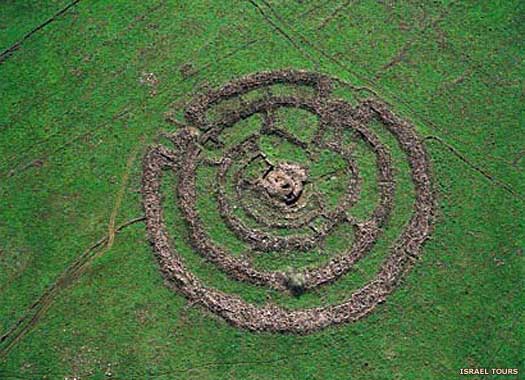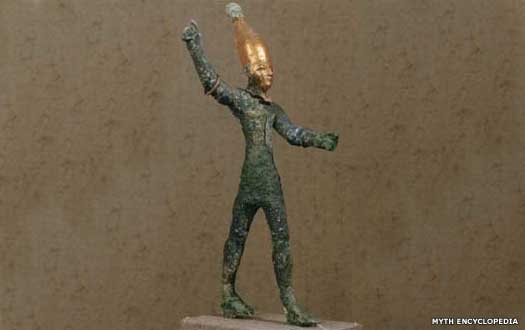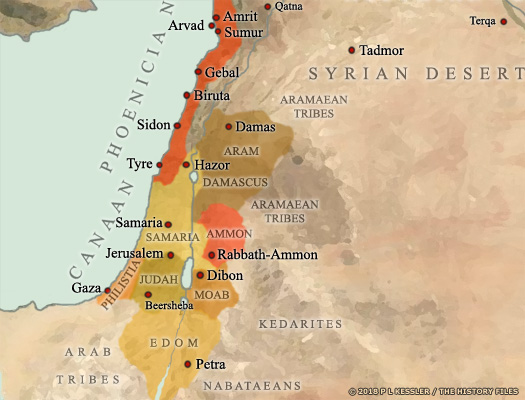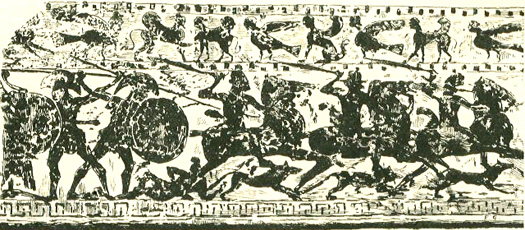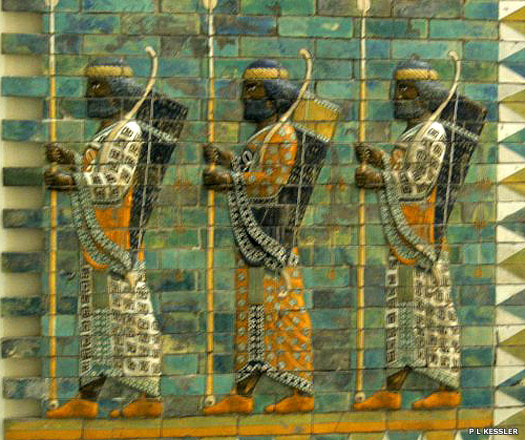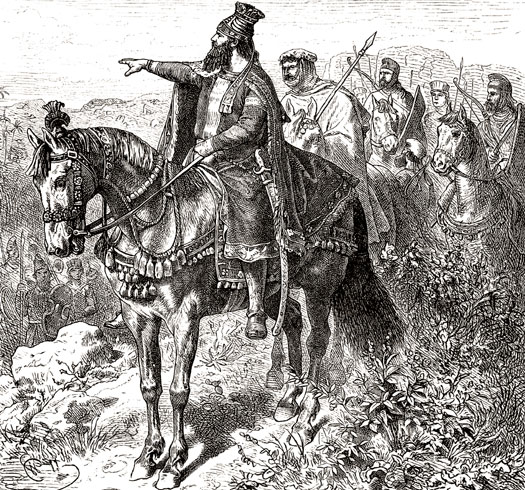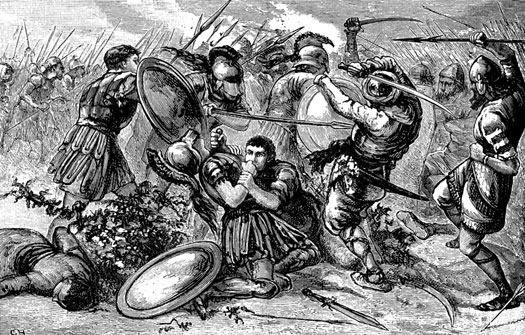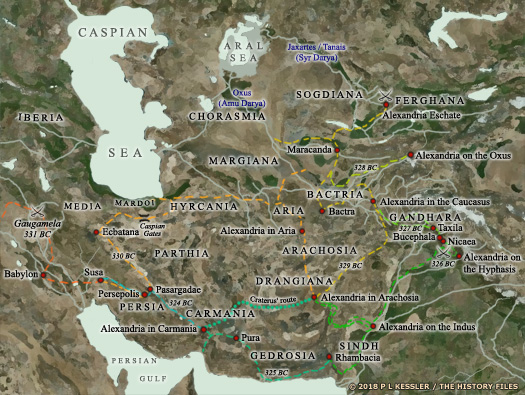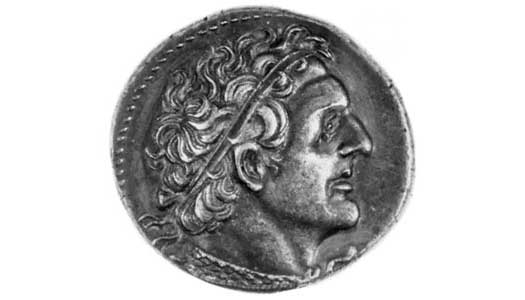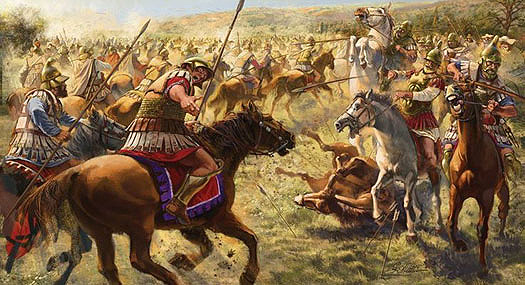
| CANAANITE CITY STATES (KENA'ANI) Ancient Canaan was the region of the coastal Near East which stretched from the Sinai near Egypt up to Syria. The name's origins are obscure, but it first appears in the third millennium BC. In the second millennium BC Canaan was a region of emerging minor city states which were superseded in the first millennium BC by fairly minor kingdoms, many of which played an important regional role but which were still highly vulnerable to conquest by the great empires. The Old Testament, mostly written down in the middle of the first millennium BC, claims that the mythical figure of 'Canaan' was the grandson of Noah.
In linguistic terms, Canaan refers to the West Semitic group of languages. The region was also the birthplace of the modern phonetic alphabet. When Egypt conquered the Levant in 1453 BC, they established their own province, which they called Kinakhna (Canaan). This would seem to be a slight distortion of the word that survives in Hebrew (a Canaanite language), which was Kena'ani, or the Akkadian Kinahna). While the two terms - Levant and Canaan - are, to an extent, interchangeable, and refer to the region south of Syria, the latter term refers to a specific section of the Levant.
(Additional information from Illustrated Dictionary & Concordance of the Bible, Geoffrey Wigoder (Gen Editor, 1986), from the NOVA/PBS documentary series, The Bible's Buried Secrets, first broadcast 18 November 2008, and from External Links: Time Maps, and Encyclopaedia Britannica.)
c.5000 BC :
Gebal is founded as a permanent settlement.
c.4000 BC :
Sidon is founded as a permanent settlement. This is at the same time as a structure of concentric stone circles known as Rujm al-Hiri is built as an astrological temple or observatory, or perhaps a burial complex. A 2011 theory proposes that it is part of an ancient method of disposing of the dead, where the flesh is removed from a body prior to the bones being buried in an ossuary, a common practise in the region at this time.
The site's name means 'stone heap of the wild cats' in Arabic. In Hebrew it is known as Galgal Refaim, or the 'wheel of ghosts'. It lies close to the militarised Golam Heights in modern Israel and is therefore seldom visited. It consists of four circles - the outermost more than 152 metres across - made up of an estimated 42,000 tons of basalt stone, the remains of massive walls that experts believe could rise as high as nine metres. It is an enormous feat of construction carried out by a society about which little is known. It seems likely that Rujm al-Hiri serves residents of villages nearby that are part of the same Chalcolithic Period agrarian civilisation that exists in the region between 4500 and 3500 BC. There is a tomb at the centre of the site which it is generally agreed is added millennium or two later (but still to early for Og of Bashan).
The site at Rujm al-Hiri dates to 4000 BC, but it was re-used around 3000-2000 BC to house a tomb, legendarily belonging to King Og of Bashan (who actually lived about 1135 BC) c.3000 BC :
Biruta is founded as a permanent settlement.
c.2800 BC :
Hazor is founded as a permanent settlement.
c.2000 BC :
Arvad is founded as a permanent settlement. Perhaps two hundred years before this the settlement of Ai (now in the Palestinian highlands of the West Bank) is destroyed. Archaeology proves this level of destruction, which had previously been ascribed to the Israelite Settlement Period (about 1170 BC), but the cause is unknown.
c.2000 - 1800 BC :
Egypt maintains a trading presence in the region.
Amorites infiltrate the area and capture some cities by force, and create others, but once they settle in, the area becomes prosperous again. The principle Canaanite cities or small states at this time include Ammon, Amrit, Arvad, Biruta, Edom, Gebal, Gerar, Hazor, Shalem, Sidon, and Tyre.
Biblical Canaanite City States / Habiru :
By around 1750 BC, the time in which the Old Testament claims that areas of Canaan were being settled by the early Israelites, the Syrian states were apparently dependencies of Elam for a short time. However, the existence of the Biblical Elamite king, Chedorlaomer, cannot be confirmed. The local Canaanite city states reported by the Old Testament in Genesis 14 are listed here, but as the Old Testament was written down over a thousand years after these events, the names became very distorted and are subject to much modern research regarding possible historical equivalents. Josephus also provides an interpretation of the names, shown after the Biblical versions here.
Outside the cities of the Levant there were populations of habiru, a range of outsiders who ranged from semi-nomadic social outcasts and those who had fled the debt-ridden city system, to unemployed farm labourers and mounted mercenary archers. Between 2000-1200 BC, these groups plagued the established order with frequent raids and looting, and the attitude to them was invariably hostile. In the Egyptian Amarna letters they were constantly presented as a threat to the stability of the region, although the regional manpower shortage was sometimes so acute that they could still be hired as labourers or mercenaries.
Originally the habiru were thought to be the early Israelites, with 'habiru' becoming Hebrew, but more recent thought suggests the Hebrews may only have been one group of habiru, probably not even aligned with the groups in the north, or else not related to them at all. The Hebrews certainly caused a few troublesome ripples of their own, migrating into Canaan from Mesopotamia, and also when they supposedly invaded Canaan in the twelfth century BC through Edom and Moab, penetrating as far north as Amurru in Syria. The context in which the habiru were mentioned differed depending upon where the references were found. Although it originally seems to have been used for any marginal people who lived outside state controls, there is nothing to preclude one such group becoming the later Hebrews. The peak of activity for the habiru seems to have been during the great social collapse at the end of the thirteenth century BC, when these rogue groups became nothing less than organised bands of raiders who were often lumped together under the heading 'Sea Peoples'.
Akkadian sources which date to the earliest years of the existence of Moab mention nomadic groups along the Trans-Jordanian highlands whom they term the Shutu. These groups extended deep into Mesopotamia, probably occupying the edges of the habitable zone there. Speculation about the Shutu mentions that the name may be a variant of the Egyptian term 'Shasu', Semitic cattle-herding nomads who operated in a clan system with tribal chieftains. While the historical identity of these Shutu is unknown, they have been linked to the Moabites and Ammonites, and may well have been amongst those groups that were labelled as habiru.
In fact the term habiru is also found in Akkadian sources (as 'hapiru') and in Sumerian (as 'Sagaz'). Texts mentioning the hapiru can be found as far back as the third dynasty of Ur, placing them sometime between 2112-2004 BC. But the attractiveness of equating them with the Hebrews gave way as soon as it was discovered that the 'apiru/SA.GAZ' were found in other texts as far afield as Babylon, Mari, Nuzi, Boghazkoi, and the aforementioned Ur.
(Additional information by Sean Bambrough (on the Amarna letters), from The Amarna Letters, William L Moran, 1992, from A Test of Time, David Rohl (Arrow, 2001), from Theological Dictionary of the Old Testament, David Noel Freedman, B E Willoughby, & Heinz-Josef Fabry (G Johannes Botterweck & Helmer Ringgren, Eds, William B Eerdmans Publishing Company, 1999), from A History of Israel: From the Bronze Age through the Jewish Wars, Walter C Kaiser Jr (Broadman & Holman Publishers, 1998), from Jewish War & Jewish Antiquities, Flavius Josephus, and from the NOVA/PBS documentary series, The Bible's Buried Secrets, first broadcast 18 November 2008.)
fl c.1750 BC :
Amraphel : In Shinar (Babylon?).
c.1750 BC :
Shinar, or Sennaar, is equated with Babylon, making the king identifiable with Hammurabi, although this theory appears to be falling out of favour with many scholars. Amraphel, allied with 'Chedorlaomer' of Elam, 'Arioch of Ellasar' (originally thought to be Rim-Sin of Larsa, but now thought more likely to be the early Hurrian King Ariukki), and 'Tidal, king of nations' (probably the Hittite king, Tudhaliya I), attack the early Israelites during a general conflict. After twelve years of paying tribute, the following Canaanite 'five cities of the plain' have rebelled:
fl c.1750 BC :
Bera / Ballas : In Sodom. No trace of Sodom has ever been found.
fl c.1750 BC :
Birsha / Barsas : In Gomorrah.
fl c.1750 BC :
Shinab / Senabar : In Admah / Adama.
fl c.1750 BC :
Shemeber / Sumobor : In Zeboiim / Zeboyim.
fl c.1750 BC :
Zoar : In Bela.
c.1749 BC :
Despite their resistance, the rebellious city states of Sodom, Gomorrah, Admah, Zeboiim, and Bela are defeated within a year. The city of Salem also figures in this period in connection with Abraham of the Israelites.
During the rebellion, Sodom is aided by Lot, adopted son of Abraham. Thereafter he is found living within the city itself, shortly before it is destroyed (as Josephus says) by means of God casting 'a thunderbolt upon the city, and set[ting] it on fire, with its inhabitants; and laid waste the country with the like burning.' Curiously, after this destruction, the vale that is home to the destroyed city is afterwards called Lake Asphaltitis.
c.1503 BC :
Thutmose I invades the Levant and Syria, sweeping through much of it. Egypt establishes a presence but does not appear to remain in force.
1453 BC :
Egypt reasserts its authority in the region by conquering territory in the Levant and Syria as far north as Amurru. The Egyptians establish three provinces which are named Amurru (in southern Syria), Upe (in the northern Levant, which may correspond to Damas), and Canaan (in the southern Levant, which includes Gebal). Each one is governed by an Egyptian official. Native dynasts are allowed to continue their rule over the small states, but have to provide annual tribute.
c.1400 BC :
Amorites capture the previously Amorite and Canaanite city of Bashan in Syria.
c.1371 - 1358 BC :
The Amarna letters between Egypt and Assyria, and the city states of Syria and Canaan, describe the disruptive activities of the habiru, painting them as a threat to the stability of the region.
Rohl's discredited theory is that the habiru of the Amarna letters are the Israelites of David. Findings may indicate that the three years of drought, famine, and plague of the Amarna letters and those of David's time may be same, but of course there is nothing to say that similar events could not be repeated over the course of the three or four hundred years between the usual dating for these two. Another theory is that Moses (an individual who is probably much closer to the period in which the Amarna letters are written than is David) is 'the rebel Mesh' of amelut-sagaz-Mesh (habiru) of the Amarna letters.
This photo shows a bronze figure from Tyre, created between 1400-1200 BC and probably representing the Canaanite god Baal in the role of a warrior c.1340 BC :
Sensing the weakness of the neighbouring Mitanni empire (as well as of Egypt), Aziru of Amurru makes a secret deal with the Hittite king, Suppiluliuma. He also establishes himself as a strong king in the region, taking control in Damas and even going so far as to conquer the city of Sumur, where the Egyptian representative has his residence. The restoration of the city is demanded, but Aziru forces Egypt to recognise him first. However, relations with Egypt are soured by constant complaints from Gebal.
c.1310 BC :
In the lead up to their confrontation with Egypt at the Battle of Kadesh, the Hittites conduct raids deep into Canaan. Rib-Adda, king of Gebal, reports to his Egyptian overlords on additional and apparently devastating raids by the habiru. He mentions the nearby minor city of Irqata (or Arqa, Biblical Arkite, which is now a village near Miniara in the Akkar district of northern Lebanon, 22km north-east of Tripoli, near the coast). Apparently the people of Irqata are among the last in their area to hold out against the habiru, along with another minor city, Sumur, and Gebal itself. Only Gebal remains unconquered.
fl c.1310 BC :
Aduna : 'King of Irqata'. Killed by the habiru.
fl c.1310 BC :
? : 'King of Sumur'. Killed by the habiru.
c.1200 - 1020 BC :
There is general collapse in the region as instability grips the Mediterranean coast for some decades, with the first, and biggest victim being the Hittite empire. It is quite possible that the habiru play some part in this. One theory holds that they unite as an identifiable Canaanite people around this time and begin to attack and conquer many of the local city states under the collective name of Israelites. Their main opponents in the south are the newly arrived Philistines and in the north the incoming Aramaeans, while some of the Sea Peoples also settle along the coast and probably contribute their skills to the region's maritime society. The ('old') Canaanites are reduced to owning the shores of Phoenicia, where cities such as Sidon and Gebal survive, and become the sea traders known as the Phoenicians.
It has been strongly suggested that the Israelites themselves are also Canaanites, and that the traditional exodus never occurs. This theory seems to be backed up by archaeological finds (although a temporary event such as an exodus would be hard to locate archaeologically). In recent years this idea has been strengthened. The climate-induced social collapse of the end of the thirteenth century BC - and the long lead-up towards it of perhaps a century - results in groups of dispossessed people congregating in Canaan in new groups (as mentioned above). Known by the established powers by various names, including habiru, these groups would appear in essence to be drop-outs from established society, people who want to find a new way of living outside what they see as an unjust and restrictive society. Following the social collapse, which terminates the Hittites and results in the declining fortunes of Egypt, these new communities seemingly emerge as a new people, with new, unfussy pottery and a monotheistic culture. They have formed the people known as the Israelites.
Midianites :
The Midianites were mentioned in the Old Testament as a minor group of 'city states' which lay on the southern borders of Edom, along the Gulf of Elath and bordered to their own south by the Arab tribes. The Moabites were nomads (which suggests that their city states were nothing like as established or permanent as those in the north of Canaan) and they controlled parts of the Arabah, the Negeb, and the Sinai. They are thought to have been connected to the Moabites through their religious practises, but little else seems to be known about them, although one opinion has suggested that they were Arabs rather than Semitics. They are also mentioned in the Qur'an as the Madyans.
c.1230 BC :
Moses begins to lead the loose confederation of Israelite tribes out of Egypt, shortly after his marriage to a Midianite woman, Zipporah daughter of Jethro the Midian priest whom he had met in the Sinai.
c.1198 BC :
Moab is defeated and subjugated by the Israelites, as are a number of minor city states, including those of the Midianites and various other Canaanite cities.
c.1198 BC :
Balaam : First-known ruler of the Midianites.
c.1198 BC :
Evi
c.1198 BC :
Rekem
c.1198 BC :
Zur
c.1198 BC :
Hur
c.1198 BC :
Reba
c.1120 BC :
Gideon of Israel defeats the Midianites after what appears to be an attempt to cattle-rustle and steal crops by the Midianites and their allies, the Amalekites.
c.1080 BC :
Israel is subdued by the Midianites to the south (probably only on a very local and temporary basis).
Jebusites :
Around the 1170s BC, the Israelite tribes are estimated to have been conquering various Canaanite cities during the creation of their own state. By this stage a Canaanite tribe known as the Jebusites, which traditionally had already been occupying the mountains near the city of Shalem in the Judean Mountains, had also occupied the city itself. According to the Old Testament, the city's king led the Jebusites from the following cities against the Israelites, but they were totally defeated and their cities were incorporated into the new Israelite state.
(Additional information from The Amarna Letters, William L Moran, 1992, and the Illustrated Dictionary & Concordance of the Bible, Geoffrey Wigoder (Gen Ed), 1986.)
c.1170s BC :
Hoham : King of Hebron (then called Kirjath-arba).
c.1170s BC :
Piram : King of Jarmuth.
c.1170s BC :
Japhia : King of Lachish (Tell Lachish/Tell ed-Duweir).
c.1170s BC :
Debir : King of Eglon (Tell el-Hesi?).
c.1170s BC :
Adonizedec of Shalem leads the fragmented Canaanite tribes against Joshua of the Israelites, but they are defeated at Gibeon and apparently suffer again at Beth-horon, not only from attacks by their pursuers, but also from a great hail storm. The five allied kings take refuge in a cave at Makkedah and are imprisoned there until after the battle, when Joshua commands that they be brought before him. They are brought out, humiliated, and put to death, and Jebusite Shalem is conquered. They take control of the city but apparently lose it again twenty years later during an invasion by the Philistines.
975 BC :
The Jebusite king Araunah is mentioned in the Old Testament in relation to Shalem during the formation of the Israelite kingdom, so he is probably the city's ruler. The Jebusites have been resisting Israelite attempts to re-take the city for some time, resorting to mocking their assailants for their failures. Now King David manages to conquer the city once and for all, taking it as his new capital and renaming it hebiru-Shalem, or Jerusalem. From this point onwards, the city serves as Israel's spiritual centre, as well as its administrative capital. When Israel divides into Samaria and Judah in 928 BC, Jerusalem serves as Judah's capital.
The Israelite Settlement Period :
The period of Israelite settlement after the supposed exodus from Egypt is a controversial and confusing time. General instability in the region had seen the fall of the Hittite empire in Anatolia, the Canaanites were being reduced in territory to the shores of Lebanon (to eventually become the sea traders known as the Phoenicians), the Philistines and other Sea Peoples were first settling on the lower coast of the Levant, and various neo-Hittite city states were arising in northern Syria, many of which came into contact with the Israelites.
These, then, are the Canaanite cities said to have been conquered by the Israelites, along with (very) approximate dates in which each city was defeated or conquered. The evidence for an Israelite conquest is very controversial, relying almost entirely on the Old Testament and showing very little basis in written documents or archaeology of the period. If it was a conquest rather than a simple transition between one ruling group of Canaanites and another then it must have been very small-scale in terms of regional politics, and probably nowhere near as important as it is portrayed by the Old Testament.
Quite the opposite, it seems. A good deal of recent archaeological examination of the region has almost entirely disproved the idea of a sweeping conquest by a newly-arrived militaristic group and their followers.
(Additional information from the Illustrated Dictionary & Concordance of the Bible, Geoffrey Wigoder (Gen Ed, 1986), and from the NOVA/PBS documentary series, The Bible's Buried Secrets, first broadcast 18 November 2008..)
c.1200 BC :
Arad the Canaanite : Ruled the south.
c.1198 BC :
The Israelites conquer Moab.
c.1170 BC :
The Canaanite king of Shalem leads the fragmented Jebusites against Joshua of the Israelites, but they are instead defeated and conquered, with their cities being incorporated into the Israelite state. Shalem becomes the Israelite capital of Jerusalem. The archaeological dating for the destruction of Jericho is actually dated to about 1500 BC, right in the middle of the period in which the Israelites are supposedly in Egypt.
c.1170 BC :
? : King of Jericho.
c.1170 BC :
? : King of Ai, near Beth-el.
c.1170 BC :
The supposed Israelite destruction of Ai cannot be confirmed. The archaeological evidence does show a layer of destruction for this city, which is located in the highlands of the modern Palestinian West Bank, but this layer has been dated to 2200 BC.
c.1160s BC :
The Jebusites are conquered by the Israelites, as are many other Canaanite city states situated in and around what becomes Judah and lower Syria, with Dor and Gezer amongst their number. Referring to them as city states may be a little grand. Probably they are little more than obscure settlements and small tribes that are taken over piecemeal.
c.1160s BC :
? : King of Hormah.
c.1160s BC :
? : King of Arad.
c.1160s BC :
? : King of Libnah.
c.1160s BC :
? : King of Adullam.
c.1160s BC :
? : King of Makkedah.
c.1160s BC :
? : King of Beth-el.
c.1160s BC :
? : King of Tappuah.
c.1160s BC :
? : King of Hepher.
c.1150s BC :
? : King of Aphek.
c.1150s BC :
? : King of Lasharon.
c.1150s BC :
? : King of Shimron-meron.
c.1150s BC :
? : King of Taanach.
c.1150s BC :
? : King of Megiddo (the Bible's Armageddon).
c.1150s BC :
? : King of Kadesh (under control of Ashtata?).
c.1150s BC :
? : King of Carmel.
c.1150s BC :
? : King of Gilgal.
c.1150s BC :
? : King of Tirzah. This city was later the original capital of Samaria.
c.1125 BC :
The kings below are all allies of Hazor in the coalition of the 'kings of Canaan' against Joshua and the Israelites at the 'waters of Megiddo'. Hazor itself is sacked and burned. Archaeological dating of its destruction produces a point around 1250 BC, more than a century before the approximate dating used here that seems to fit best with Old Testament events.
c.1125 BC :
Jobab : King of Madon. Ally of Hazor.
c.1125 BC :
Shimron : King of Achshaph. Ally of Hazor.
c.1125 BC :
Hermon : King of the Hivites of the land of Mizpah. Ally of Hazor.
Phoenician & Canaanite City States :
The 'Phoenicians' would not have recognised this term in relation to them. They were Canaanites, the descendants of peoples who had previously populated much of the Levant, but who were now hemmed in on a long Mediterranean coastal strip by various more recent arrivals, such as the Israelites (largely Canaanites themselves), the Philistines, the Sea Peoples, and the Aramaeans. Relatively unscathed by the chaos of the twelfth century collapse, from this fertile region they quickly prospered. Replacing the region's previous dominant trading power, Ugarit, they created an even greater trading empire of their own which stretched across the Mediterranean. Some scholars argue that because their sailing ability, which was not well attested before the collapse, suddenly became very pronounced afterwards, the Phoenicians may have intermingled with some of the Sea Peoples to produce this more dynamic branch of Canaanites.
Their civilisation was organised into city states on the same pattern as the ancient Greeks and Syrians. Each city state was politically independent, and would suffer domination by another city, come into conflict with it, or prosper through intermarriage and trade. Sidon and Tyre were the most powerful Phoenician cities, but in time the colonies in North Africa proved to be more powerful than either of them. Close allies with the Israelites, the Phoenicians intermarried with them from the eleventh century onwards, and greatly influenced Israel's architecture.
Phoenician & Canaanite City States :
(Additional information from A Royal Dedicatory Inscription from Ekron, S Gitin, T Dothan, & J Naveh (Israel Exploration Journal 47, 1997), from The History of Esarhaddon (Son of Sennacherib) King of Assyria, BC 681-688, Ernest A Budge, and from External Link: Encyclopaedia Britannica.)
The principle Phoenician cities along the coast are Biruta, Byblos, Hazor, Tyre, Sarepta, and Sidon. Other Canaanite cities include Ammon, Dor, Edom, and Moab, while the Philistines establish city states of their own further south. Arabs from the peninsula, who are camel nomads, are in close contact with he Syro-Palestinian region and provide luxury goods such as incense from Saba.
1104 BC :
This is the traditional date upon which the colony of Gadir is founded in southern Iberia. No archaeological evidence for occupation at this date can be found but, as with the colony of Utica, this is probably because these posts are temporary at first, and are not permanently occupied until the ninth century.
A colony is also founded at Utica, and further colonies are founded (and permanently settled between the eighth and seventh centuries) at Hadrumetum (Susah, Sousse), Lixus, Mogador (Essaouira, the most distant Phoenician colony), Siga (Rachgoun), and Tipasa (east of Cherchell). Finds of a similar age have been made at Motya (Mozia) in Sicily, Nora (Nurri), Sulcis, and Tharros (San Giovanni di Sinis), Bithia, Bosa, Caralis, Nora, Olbia, Sulcis, and Tharros on Sardinia, and Gadir and Almuńecar in Spain.
c.1050 BC :
A weakened Egypt loses its remaining imperial possessions in Canaan. The Phoenician city states expand their territory at this time, but are checked in the south by the Philistines. Archaeological evidence for a mass settling of people in this southern region and at this time has yet to be found, suggesting that the Philistines are formed of small, mobile groups who take a while to establish themselves and take control of the region.
Shiloh is a Canaanite town that has become the central sanctuary site of the Israelite confederacy during the period of the judges. Following the Israelite conquest of Canaan, the Tabernacle and the Ark of the Covenant had been installed in Shiloh, but the Ark is now captured by the Philistines during a battle at Ebenezer (site unknown), and Shiloh is soon afterwards destroyed. Excavations at Khirbat Sayūn in modern Jordan during 1920-1932 suggest that Shiloh remains a ruin for several centuries. The Philistines decide to return the Ark after about seven months.
c.1035 BC :
The kingdom of Israel is founded while the Phoenicians are creating trading posts along the North African coast, such as Carthage and Utica, in southern Italy, in the Mediterranean, such as Kition on Cyprus and on Corsica, and in southern Spain, such as Gadir and Tarshish. Merchants are also known to trade with the occupants of the Land's End region of Britain, the ancestors of the Dumnonii tribe, and general opinion is that these traders are Phoenicians, although there is no surviving proof.
fl c.1000? BC :
Rehob : King of Zobah.
fl c.970? BC :
Hadadezer : Son. King of Zobah. City fell to David and the Israelites.
c.970? BC :
The Old Testament recounts that 'when David destroyed Zobah's army, Rezon gathered a band of men around him and became their leader; they went to Aram Damascus (Damas) where they settled and took control'. This Rezon is a young officer of Zobah, the son of Eliada, who escapes the city's fall and establishes himself in Damas, where he 'founds' Aram Damascus - in other words he takes control of it with his band of men - and severely threatens Israel and its northern successor, Samaria. The changes mean that Damas also replaces the eclipsed Zobah as the main centre of Aramaean power in the Levant.
928 - 840 BC :
The break-up of Israel in 928 BC allows Damas to rapidly grow in power and at times even threaten the existence of its southern neighbour. It also gains the important caravan routes westwards to the Phoenician ports, bringing immense wealth into the city.
In the ninth century, the Assyrians invade and subjugate Syrian states, including Bit Adini, Bit Agusi, Carchemish, and Pattin, by which time many small and semi-obscure cities have arisen, such as Gamgum and Gan Dunias, along with the kingdom of Kedar in eastern Syria. However, the Assyrians don't have it all their own way. In 853 BC they are defeated by a coalition of Syrian and Canaanite states which seems to be led by Damas, and around 840 BC it is Damas which is the dominant city state in the region, not the Assyrians.
When the Neo-Assyrian empire threatened the various city states of southern Syria and Canaan around 853 BC, they united to protect their joint territory - successfully it seems, at least for a time 738 - 676 BC :
The end of the region known as Philistia (Palestine), as well as the remaining cultural Philistines, now comes when the Assyrians sack the remaining towns and cities and sells the inhabitants into slavery. The city of Ashkelon may be the last to fall, in 701 BC. Subsequent kings appear in Ekron (at least), but they write their inscriptions in a Canaanite dialect that is very close to Phoenician. All of the Phoenician states also become vassals of Assyria, but local arrangements for governance are left in place.
However, the conquest is not total. In 679 BC Esarhaddon of Assyria conducts a campaign against the Cimmerians. He defeats them and their leader, Teuspa, in the region of Hubusna (probably Hupisna-Cybistra), but the area is not pacified. In the same year Esarhaddon's troops also fight a war in Hilakku (Khilakku), and a few years later they punish the Anatolian prince of Kundu (Cyinda) and Sissu (Sisium, modern Sis), who has allied himself with Phoenician rebels against Assyrian rule. The regions to the north of the Cilician plain repeatedly cause trouble for Assyria.
This image shows Cimmerians battling early Greeks - prior to the advent of accepted 'Classical' Greece - with the mounted Cimmerians warriors apparently being accompanied by their dogs 676 - 612 BC :
Assyria conquers all of Phoenicia. However, despite being under the nominal control of the Assyrians, the Phoenicians continue their highly profitable trading enterprises in the western Mediterranean. They begin to move farther inland on Sardinia in their hunt for important natural resources such as lead and silver mines. They establish a fort on Monte Sirai, the oldest-known Phoenician military building in the west, presumably to protect their acquisitions from an increasingly hostile native Sardi people.
612 - 573 BC :
The Phoenician cities appear to regain their freedom after the destruction of the Assyrian empire. Illusions of freedom are insubstantial, however. A resurgent Egypt battles against Babylonia towards the end of the seventh century, conquering and then losing control of Syria and then barely being able to hold onto Canaan.
573 - 539 BC :
Having already secured Syria and destroyed the Assyrian empire, Babylonia now conquers Phoenicia. As a result, many Phoenicians emigrate to the colonies, especially Carthage, which quickly rises to become a major power.
Later
Phoenicia :
Taken by Cyrus the Great as part of his capture of Babirush (Babylon) in 539 BC, the city states of Phoenicia were added to the Persian empire. Under its control, Phoenicia formed part of a large satrapy which was commanded from Babirush. This was the senior great satrapy in the region. The main satrapy of Athura (former Assyria) fell within Babylonia's administrative umbrella and was subservient to it just as was Phoenicia. It was Strabo who reported (accurately) that Athura consisted of (old) Assyria along with Khilakku, Syria, and Phoenicia.
Later Syria seems to have been established as a satrapy in its own right away from oversight by Babylon, under the name of Ebimari or Ebir-nāri (Babylonian) or Abar-Nahra (Aramaic-Persian). Once Syria was stripped away from Athura, thereby lessening Babylonia's own importance, the post of Babylonian satrap was poorly attested. The province extended from the Amanus to Sinai and included Salamis on Cyprus. The administrative divisions of the Syrian province were likely the same as during Neo-Babylonian rule (Damas, Hamath, and Hauran, within later Batanea) and the capital was probably Damascus or the Phoenician city of Sidon. Persian freedom laws allowed the cities of the Levant to continue to practice their own religions, carry out their own commercial activities, and establish colonies along the Mediterranean coast.
By the time of their domination by the late Assyrian empire and then the neo-Babylonians, the Phoenicians had lost a good deal of their political and economic strength. Their trade, however, was still very strong, and they continued to be prolific ship-builders and sailors, losing nothing of their proclivity for independent thought or strength of will. Although they provided a fleet which was vital to Cambyses in the conquest of Mudrāya (Egypt), the Phoenicians refused to help him in his proposed attack on Carthage, their ancient colony, and the idea was abandoned. However, they sided with the Persians against the Greeks in the wars (490-449 BC), which were, from a Syrian point of view, a precious occasion for getting rid of the Greek presence in the Mediterranean. There's nothing like a good war for weeding out direct competition!
(Information by Peter Kessler, with additional information from Alexander the Great, Krzysztof Nawotka (Cambridge Scholars Publishing, 2009), from The Persian Empire, J M Cook (1983), from The Phoenicians: A Captivating Guide to the History of Phoenicia and the Impact Made by One of the Greatest Trading Civilizations of the Ancient World (Captivating History, December 2019), from The Histories, Herodotus (Penguin, 1996), from A Dictionary of Greek and Roman Biography and Mythology, William Smith (Ed), and from External Links: Encyclopędia Britannica, and Encyclopaedia Iranica, and The Government of Syria under Alexander the Great, A B Bosworth (The Classical Quarterly Vol 24, No 1, May, 1974, pp 46-64, Cambridge University Press on behalf of The Classical Association (available at JSTOR)), and Geography, Strabo (Loeb Classical Library Edition, 1928).)
539 BC :
Despite the fall of Babirush itself to the Persians, it is entirely possible that pockets of resistance remain - or at least areas in which Persian overlordship is tacitly acknowledged while local rule is maintained on a semi-independent basis, at least for a time. The Chaldeans who had provided Babylon's last dynasty of kings may be one such case. Although specific details are not recorded, the Book of Daniel seems to retain a memory of this in Belshar-uzur.
All of Phoenicia is submerged within the Persian empire at the same time. Many Phoenicians emigrate to the colonies, especially Carthage, which quickly rises to become a major power. The many other colonies in the western Mediterranean also become more important. On Sardinia, for instance, Phoenicians mount a defence against a native Sardi uprising that secures them control of much of the island.
This Achaemenid (Persian empire) palace decoration stood in the city of Babylon and was transported to Berlin upon being rediscovered by archaeologists in the twentieth century 539 - 537? BC :
? : Babylonian satrap of Mesopotamia, Ebir-nāri, & Phoenicia.
539 BC :
One Belshar-uzur in Babirush may legitimately claim to be the true successor to the Babylonian throne even though he holds no power and doesn't have the resources to enforce his claim. He is apparently killed by Cyrus the Great even though his father is allowed to live, so he cannot be the otherwise unknown Babylonian satrap for the first couple of years of Persian rule before being replaced by Gaubaruva. Instead, as Cyrus allows existing offices to be retained at first, this post is probably still filled by its Neo-Babylonian incumbent.
537? - 522 BC :
Gaubaruva / Gobryas / Gobares : Persian satrap of Babirush (Mesopotamia), Ebir-nāri, & Phoenicia.
537 BC :
Gaubaruva is appointed as the first Persian satrap of Babirush. He is known by a whole host of interpretations of his name, from the Old Persian Gaubaruva or the Akkadian Gubaru, to the Greek Gobryas, and the Latin Gobar(es). He can also be equated with the Cyaxares of the Cyropaedia, but should not be confused with the General Ugbaru (Old Persian) or Gobryas (Greek) who aids Cyrus the Great in the conquest of Mesopotamia (a mistake made in the Grayson version of the Nabonidus Chronicle). Ugbaru may in fact govern the district or province of Gutium for a short time before dying, having already reached an advanced age.
Cyrus the Great freed the Indo-Iranian Parsua people from Median domination to establish a nation that is recognisable to this day, and an empire that provided the basis for the vast territories that were later ruled by Alexander the Great 524? - 516 BC :
Utani / Ushtanni : Satrap of Babirush (Mesopotamia), Ebir-nāri, & Phoenicia.
c.484 - 482 BC :
Although any records to prove it have not survived, it would seem to be in this period, between about 490-482 BC, in which Ebir-nāri is created a satrapy in its own right, removing it (and therefore Phoenicia) from the administration of Babirush (Babylonia). The cause may well be the revolt in Babylonia which arises shortly after a greater revolt in Mudrāya. In fact tablets from Babylonia seem to show evidence of two risings by claimants to the Babylonian throne. The first is a minor affair, but the second, in 482 BC, seems more serious.
480 BC :
Invading Greece in 480 BC, the Persians subdue the Macedonians and the Thracian tribes (except for the Satrai, precursors to the Bessoi). Then the vast army of Xerxes makes its way southwards and is swiftly engaged by Athens and Sparta in the Vale of Tempe. The Persian army is held up long enough for the Athenians to prepare their navy for a seaborne engagement with the Persian fleet.
Athens, as the leader of the coalition of city states known as the Delian League, fights the Persian navy at the battles of Artemisium and Salamis, the latter being a resounding Greek victory. Tetramnestus, son of Anysos of Sidon, is present - along with Anysos himself, and other leading Phoenicians such as Mattan of Tyre - but the battle leaves much of the Persian navy destroyed and Xerxes is forced to retreat to Asia, leaving his army in Greece under Mardonius.
fl 407 & 402 BC :
Bēlsunu / Bel-shunu / Belesys : Satrap of Athura, Ebir-nāri, & Phoenicia.
fl 401 & 387 BC :
Abrocomas : Satrap of Ebir-nāri & Phoenicia.
401 BC :
Cyrus, satrap of Asia Minor, attempts to revolt, mobilising an army and ten thousand Greek mercenaries to attack his brother. Defeat leads to his death in October 401 BC at the Battle of Cunaxa. Abrocomas, having been assembling forces for a re-invasion of a now-independent Egypt, marches to the assistance of Artaxerxes II. He arrives following the battle's conclusion but the extra manpower is no doubt ideal in handling mopping-up operations.
The Battle of Cunaxa saw the end of just one in a number of internal Persian revolts that often involved thousands of troops on either side, although in this case the presence of a large body of Greek mercenaries should have been an indicator of the future threat the Greeks would become 389 - 387 BC :
Abrocomas joins two Persian army commanders - Pharnabazus (not to be confused with Pharnabazus II of Phrygia) and Tithraustes (former satrap of Sparda) - in the attempted reconquest of Egypt. Their efforts meet with little success as the Egyptians have relearned how to defend their country.
fl 351/350 BC :
Bēlsunu / Bel-shunu / Belesys : Satrap of Ebir-nāri & Phoenicia.
346 BC :
In tandem with Satrap Mazaeus of Khilakku, Bēlsunu of Ebir-nāri and Phoenicia leads fresh contingents of Greek mercenaries to put down the revolt in the Levant (principally led by Sidon). The main attack falls on Sidon but both satraps are repulsed. The Persian king himself is forced to follow up with a more direct intervention.
mid-300s BC :
Dernes : Satrap of Phoenicia & Arabāya.
? - 333 BC :
Arsames : Satrap of Athura, Ebir-nāri, Khilakku & Phoenicia. Killed.
333 - 332 BC :
In 334 BC Alexander of Macedon launches his campaign into the Persian empire by crossing the Dardanelles. Much of Anatolia falls by 333 BC and Arsames falls (whilst also officially satrap of Arabāya). Alexander proceeds into Syria during 333-332 BC to receive the submission of Ebir-nāri, which also gains him Harran, Judah, and Phoenicia (principally Byblos and Sidon, with Tyre holding out until it can be taken by force). Athura, Gaza, and Egypt also capitulate (not without a struggle in Gaza's case). Mazaeus of Athura initially plays his part by opposing Alexander, but he eventually surrenders, and Alexander makes him satrap of Mesopotamia.
Argead Dynasty in Phoenicia :
The Argead were the ruling family and founders of Macedonia who reached their greatest extent under Alexander the Great and his two successors before the kingdom broke up into several Hellenic sections. Following Alexander's conquest of central and eastern Persia in 331-328 BC, the Greek empire ruled the region until Alexander's death in 323 BC and the subsequent regency period which ended in 310 BC. Alexander's successors held no real power, being mere figureheads for the generals who really held control of Alexander's empire. Following that latter period and during the course of several wars, Phoenicia was left in the hands of the Seleucid empire from 301 BC.
Later Persian Ebir-nāri (Syria) seems to have been established as a satrapy in its own right away from oversight by Babirush (Babylonia). Once Syria was stripped away from Athura, thereby lessening Babylonia's own importance, the post of Babylonian satrap was poorly attested. The Persian province of Ebir-nāri extended from the Amanus to Sinai and included Salamis on Cyprus. The administrative divisions of the Syrian province were likely the same as during Neo-Babylonian rule (Damas, Hamath, and Hauran, within later Batanea) and the capital was probably Damascus or Sidon.
Persian freedom laws allowed the cities of the Levant to continue to practice their own religions, carry out their own commercial activities, and establish colonies along the Mediterranean coast. Much the same was true during Greek domination of the region for the next three hundred years. All the Phoenician cities surrendered to Alexander the Great in 332 BC - except for Tyre, which had to be besieged but which was eventually captured.
(Information by Peter Kessler, with additional information from Alexander the Great, Krzysztof Nawotka, from The Persian Empire, J M Cook (1983), from The Histories, Herodotus (Penguin, 1996), from The Cambridge Ancient History, John Boardman, N G L Hammond, D M Lewis, & M Ostwald (Eds), from Anabasis Alexandri, Arrian of Nicomedia, and from External Links: Encyclopędia Britannica, and Encyclopaedia Iranica, and The Government of Syria under Alexander the Great, A B Bosworth (The Classical Quarterly Vol 24, No 1, May, 1974, pp 46-64, Cambridge University Press on behalf of The Classical Association (available at JSTOR)).)
332 - 323 BC :
Alexander III the Great : King of Macedonia. Conquered Persia.
323 - 317 BC :
Philip III Arrhidaeus : Feeble-minded half-brother of Alexander the Great.
317 - 310 BC :
Alexander IV of Macedonia : Infant son of Alexander the Great and Roxana.
331 BC :
With a Samaritan insurgency dealt with, Syria seems to be securely under Macedonian Greek control. From around this point onwards it seems to revert to a single satrapal territory with only one incumbent. The post is given to Menes at the end of 331 BC who also commands a rather vast swathe of neighbouring territory.
The route of Alexander's ongoing campaigns are shown in this map, with them leading him from Europe to Egypt, into Persia, and across the vastness of eastern Iran as far as the Pamir mountain range 331 - 323? BC :
Menes : Greek satrap of Athura, Cilicia, Phoenicia, & Syria.
329 BC :
The appointment of Menes (probably the son of Dionysius who had been raised to the circle of Alexander's 'Bodyguards' in 333 BC - a major distinction which would mark him out as a commanding figure) in such a satrapal role over so much territory has been called into question by scholars. He has even been labelled as nothing more than a communications officer despite scholars linking him the the 'Bodyguards' role.
329 - 328? BC :
? : Unnamed deputy or stand-in? Either way, Menes is not in direct command of Syria in 329 BC, but around 332 BC the satrap of Cilicia, Balacrus, is killed in battle and Menes may be required there as well as in Syria as a matter of urgent expediency, while Alexander's crossing of the Euphrates is imminent. The fact that Menes is also in Zariaspa in Bactria in 329 BC with his own levy of troops makes it clear that his appointment is largely to retain peaceful control without launching any unnecessary offensives against remaining pockets of Persian resistance while raising as many recruits as possible for Alexander's drive eastwards. However, records regarding Syria (and therefore Phoenicia) now fall silent until the death of Alexander, so Menes may well retain his position until then once he has returned from Bactria.
323 - 319 BC :
Laomedon of Mitylene : Greek satrap of Syria and Phoenicia.
323 - 320 BC :
Immediately following Alexander's untimely death, Syria and Phoenicia are assigned to Laomedon. He is confirmed in his position during the second partition of Alexander's empire in 321 BC in the middle of the First War of the Diadochi, while Cilicia has been separated as a satrapy in its own right. But Ptolemy of Egypt soon begins taking an interest, offering him a large bribe to hand over his satrapy. When Laomedon declines his offer, Ptolemy sends an army under the command of Nicanor to take it by force by 318 BC.
Shown here is an Hellenic-era Egyptian coin which displays the head of Ptolemy I, Greek founder of Egypt's Ptolemaic dynasty following the death of Alexander the Great Laomedon has little with which to resist so he is taken prisoner, escapes, and seemingly joins the general opposition to the Antigonids. His final fate is unknown while Antigonus governs Syria (and Phoenicia) during the period of the remaining Wars of the Diadochi.
318 - 313 BC :
Ptolemy : Greek ruler of Egypt. Evacuated.
319 - 301 BC :
The domination of Syria and Phoenicia by Ptolemy of Egypt briefly comes to an end in 313 BC when he joins the widespread opposition to the Antigonids. In 312 BC Seleucus Nicator defeats Demetrius, son of Antigonus, at the Battle of Gaza which briefly allows Ptolemy to reoccupy Coele Syria. Following a reversal in battle fortunes he pulls out again as Antigonus invades Syria in strength to occupy it.
312 BC :
Ptolemy : Greek ruler of Egypt. Briefly retook the region.
312 - 301 BC :
Antigonus Monophthalmus (One Eye) : Antigonid ruler. Commanded through conquest.
301 - 63 BC :
Much of Syria and Phoenicia are gained by the Hellenic Seleucid empire following the decisive Battle of Ipsus in 301 BC, although Seleucus allows Ptolemy to retain Coele Syria. Seleucus had already declared himself king of Syria and Babylonia in 305 BC, immediately founding the city of Seleucia in Mesopotamia by massively rebuilding and expanding an existing settlement. Now he also founds the city of Antioch on the Orontes (Syrian Antioch). Over the years, the Seleucids go to war against Ptolemaic Egypt over the rest of Syria, with full possession finally being gained at the end of the Fifth Syrian War in 195 BC.
The Battle of Ipsus in 301 BC ended the drawn-out and destructive Wars of the Diadochi which decided how Alexander's empire would be divided In time, though, crushed out of existence by the Romans on one side and the Parthians on the other, the Seleucid empire is terminated by 63 BC. Antiochus XIII, the last Seleucid ruler of any kind, is dethroned by Pompey when he turns Syria into a Roman province. Antioch on the Orontes (Syrian Antioch) continues to be an important city throughout the subsequent Roman period, and serves as a major centre of early Christianity.
63 BC - AD 1918 :
With the final fall of the Seleucids in 63 BC, Phoenicia is taken by Rome. It remains within the republic, its subsequent empire, and later the Eastern Roman empire even while Europe is falling to barbarian kingdoms. In AD 551, much of Phoenicia is destroyed by a great earthquake. The cities decline in importance and archaeological evidence from this period is fragmentary.
In 637 the Islamic empire sweeps through the region, conquering everything in its path. A degree of decline and fragmentation sets in following the invasion of the Near East in the tenth and eleventh centuries by Seljuq Turks, making Phoenicia ripe for conquest by the Crusaders.
In 1291 the region falls under the Mameluke sultans who, in turn, are conquered by the Ottoman empire in 1517. From 1697, while still nominally part of the Ottoman empire, the Shihabi amirs of Lebanon are semi-independent, although direct rule is re-established in 1842. In 1918 the French mandate of Lebanon is established.
Source :
https://www.historyfiles.co.uk/ |
